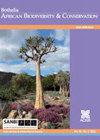城市强度和花卉群落结构驱动开普敦猴甲虫聚集
IF 0.5
4区 生物学
Q4 PLANT SCIENCES
引用次数: 0
摘要
背景:城市景观为传粉媒介的保护提供了重要的机会,但对非洲城市生境中传粉媒介种群的现状和分布知之甚少。这表明全球对城市传粉媒介的理解存在重大差距,特别是在快速城市化的背景下。本研究利用访花甲虫的一个物种分支(鞘翅目:金龟科:金龟科)来探索南非一个主要大都市地区传粉媒介的分布模式。目的:我们调查了城市强度梯度(根据每个采样地点1平方公里内土壤密封的百分比定义)和社会经济状况的群落组成,以确定传粉媒介对这些城市景观影响的反应。方法:于2018年和2019年南方春季选取142个地点进行2次调查。收集了生境结构、花卉多样性和传粉者多样性的数据。结果:研究发现,不同的取食行会对不同程度的城市密集度有利,甲虫丰富度与花的丰富度显著相关。然而,它与多样性无关,这表明丰度受到的影响小于存在的物种数量。对城市强度具有中等敏感性的猴甲虫受益于其偏爱的花卉种类的存在。结论:总体而言,研究结果表明植物群落组合在支持城市猴甲虫方面具有重要意义。我们建议在城市公园中使用首选花卉进行景观美化,以支持城市传粉者。本文章由计算机程序翻译,如有差异,请以英文原文为准。
Urban intensity and flower community structure drive monkey beetle assemblage in Cape Town
Background: Urban landscapes present an important opportunity for pollinator conservation, but little is known about the status and distribution of pollinator populations in urban habitats in Africa. This represents a major gap in the development of a global understanding of urban pollinators – particularly from the rapidly urbanising context. This study uses a speciose clade of flower-visiting beetles (Coleoptera: Scarabaeidae: Hopliini) to explore patterns of pollinator distribution in a major metropolitan area in South Africa.
Objectives: We investigated community composition across gradients of urban intensity (defined according to the percentage of soil-sealing within 1 km2 of each sampling location) and socio-economic status to determine pollinator responses to these urban landscape effects.
Methods: A selection of 142 sites were surveyed twice in the austral spring seasons of 2018 and 2019. Data were collected on habitat structure, flower diversity, and pollinator diversity.
Results: The study found that different feeding guilds of monkey beetles favoured different levels of urban intensity and that beetle richness significantly correlated with flower richness. It did not, however, correlate with diversity indicating that abundance is less impacted than the number of species present. Monkey beetles with moderate sensitivity to urban intensity benefitted from the presence of preferred species of flowers.
Conclusion: Overall, the findings demonstrate the importance of plant community assemblage in supporting urban monkey beetles. We recommend landscaping with preferred flower species in urban parks to support urban pollinators.
求助全文
通过发布文献求助,成功后即可免费获取论文全文。
去求助
来源期刊

Bothalia
生物-植物科学
CiteScore
1.70
自引率
0.00%
发文量
12
期刊介绍:
Bothalia: African Biodiversity & Conservation is published by AOSIS for the South African National Biodiversity Institute (SANBI) and aims to disseminate knowledge, information and innovative approaches that promote and enhance the wise use and management of biodiversity in order to sustain the systems and species that support and benefit the people of Africa.
The journal was previously published as Bothalia, and had served the South African botanical community since 1921. However the expanded mandate of SANBI necessitated a broader scope for the journal, and in 2014, the subtitle, African Biodiversity & Conservation was added to reflect this change.
 求助内容:
求助内容: 应助结果提醒方式:
应助结果提醒方式:


